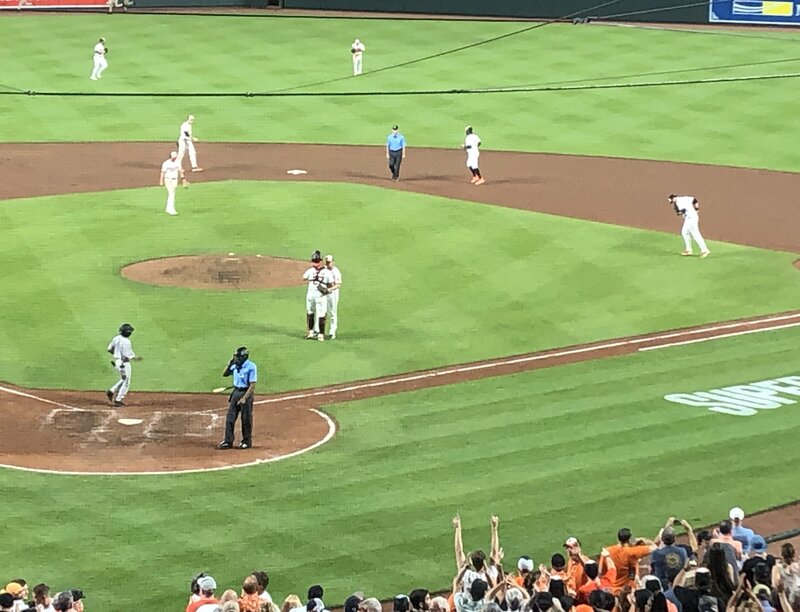and came in the 1990’s?
PLENTY, trust me!
EVERYWHERE I WENT, the first thing people would say to me when I said the word “Baltimore” was: “Geez, that’s a pretty ballpark you’ve got there, huh?”
And it changed the image of our city — from a smokestack, hayseed village off of I-95 between Washington and Philadelphia (most people from anywhere BUT here used to think of it as “The Highway to Hell” because the Harbor Tunnel backups in the 1970’s would add an hour to everyone’s trip in either direction!)
Do you know how many people live in this city right now who came here for a weekend in the 1990’s when they were in college, went to a ballgame, got drunk, got laid, had a great weekend and decided to move here?
(And those are just the people from Pittsburgh!)
I’ve seriously dated a DOZEN girls myself who had a similar story to tell.
And baseball and the Orioles and that shiny new ballpark made that happen!
It looks like such a fixture now — and sometimes it seems overshadowed by the football stadium, especially from I-95 — but do you remember the first time you saw it?
The brick facade, the black roofing, the green seats, the giant Warehouse rising above everything west of the Inner Harbor?
Being a fan who had actually sat in a LOT of stadiums at that point — virtually every time I left the city it was to see baseball — it was incomparable.
The ivy of Wrigley. The asymmetrical design of the Polo Grounds and the old parks. The walkway behind rightfield resembling the alley behind Fenway Park. Boog’s BBQ in deep right-center. The look of the bleacher seats (excuse me, the Eutaw Street reserved).
Other than a few flawed seats down the lines, virtually every seat was better than any seat on 33rd Street.
It wasn’t a stadium, it was a BALLPARK, the essence of old-time baseball captured for posterity and even, dare we say, IMPROVED upon!
And, more so than most baseball franchises, this BALTIMORE Orioles organization had, well, for lack of a better term — a “soul.”
It had The Oriole Way. It had a rich tradition of winning championships in three straight decades (only the Yankees could boast that as well) and competing on a consistent basis for the better part of a generation.
 It had legendary black stars in Eddie Murray and Frank Robinson (and don’t think that’s not important, having a multi-racial and multi-cultural team that understands this community). It had legendary, if not mythic, local stars in hometown boy Cal Ripken and Brooks Robinson, who lived here for 20 years after he played. It had a Hall of Fame pitcher in Jim Palmer and a notoriously cranky manager in Earl Weaver.
It had legendary black stars in Eddie Murray and Frank Robinson (and don’t think that’s not important, having a multi-racial and multi-cultural team that understands this community). It had legendary, if not mythic, local stars in hometown boy Cal Ripken and Brooks Robinson, who lived here for 20 years after he played. It had a Hall of Fame pitcher in Jim Palmer and a notoriously cranky manager in Earl Weaver.
It had a legendary broadcaster in Chuck Thompson, and another, in Jon Miller, who was about to become a legend.
It even had a legendary fan in “Wild” Bill Hagy!
Around here, we think of all of this as “no big deal.”
Well, you’re wrong!
But think about it: Baseball circa-1992!
What stars or Hall of Famers or “favorite stories” did they have in Cleveland? Or Houston? Or Seattle? Or Anaheim? Or San Diego? Or Montreal? Or Atlanta? Or Texas?
Not to mention the Cubs or the Red Sox century of ineptitude.
Where were their World Series stories?
Where were their big games, and big crowds and Hall of Fame players?
Where was their new stadium downtown?
All of those places had spent a generation or more WISHING they had something going on in their communities like what we had with the Orioles (and yes, the Colts) out on 33rd Street.
Wanna know how envious they were of Baltimore: they, TOO, quickly built stadiums (or lost a team trying to get one built) in an attempt to infuse energy and economic impact into their urban situations































